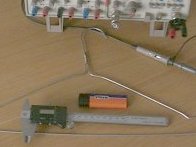
In this experiment the velocity of sound in steel (as a longitudinal wave) will be measured with a piezo element ( the electro-mechanical transducer), a steel shirt hanger, a sliding caliper, a signal generator and an oscilloscope.
 |
General idea
The idea is to find the resonance frequency of the transducer and to couple a piece of steel wire with about the same resonant frequency to the element. Observing the frequency response with and without the wire will show the resonance frequency of the steel wire.
Resonator
A simple resonator for a longitudinal wave is straight a piece of wire of half a wavelength. To get a good resonance, the element is fixed in the nodal point of the oscillation which is in the middle of its length.
Piezo Element
The transducer can is taken from a cheap electric lighter. This is probably the cheapest way to get a piezo element. Such elements are also available as electronics parts (for the price of 3 disposable lighters). Just the connection is in some cases just made over a gap which can be bridged just by the spark.
 |
Set up
Working with just one transducer coupled to the measuring object provides a very simple mechanical set up. The coupling is made by leaning the wire vertically onto the transducer by the weight of the holder (2N), which provides a lose mechanical coupling (fig 2a).
When the measurement is made with just one transducer the electrical coupling has to be very loose to detect the feedback via the same connection.
In this case the connection between the signal generator and the transducer is made via a small capacitor of just 33pF and the Oscilloscope to detect the feedback is connected to the transducer.
Experiment
The transducer alone shows a resonance at around 75kHz (fig 2b). Then probes are taken from the hanger with a length of half a wavelength. As the estimated velocity is 5000m/s the probes are in the region of 5000m/(2*75000) = 33mm. A set of probes are taken with a length of 25 to 60mm. When a probe is connected to the transducer a comparably sharp additional resonance cuve becomes visible (fig 2c).
Result
The measured velocity of speed over all measured samples is 5134m/s (fig 4). The precision of the measurement is in the range of 1%. It could be improved with this method to about 0,05%.